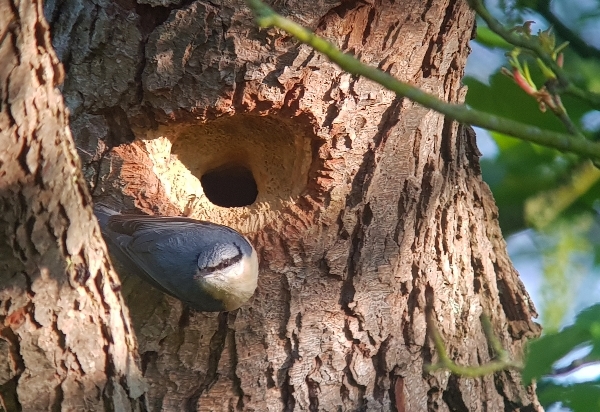
MORNING WALK INTO YEO VALLEY
WEATHER: dull and overcast, thick cloud cover, some very light rain. temp 15C
As forecast by the BBC last night this morning was very dull, with thick dark clouds looming over the village, rain threatened but held off.
It was relatively quiet for the first part of the walk, I only heard a Blackcap singing and a couple of Jackdaws calling. Once I was on the track and into the valley things picked up and soon I was totally immersed in my hobby, loving the Robins, Dunnocks, Wrens and Blackbirds.
My first stop along the stream was at the footbridge where the Nuthatch nest was, I could see that the entrance hole was almost now back in its original state, that is, minus most of the mud that the Nuthatches had put there. I can only assume that a marauding Great Spotted Woodpecker had paid another visit. I think the nest hole is now totally abandoned and of no further use this year. I can take some comfort from the whole Nuthatch/Woodpecker saga for two reasons: the first is the knowledge that at least a couple of Nuthatch chicks fledged so it wasn't a complete waste of time, and secondly, it has given us all some tremendous entertainment over the last couple of months.

Above is the finished article, picture taken back in May and below is the nest bhole today. You can see how much bigger the entrance is due to the mud being pecked away by Woodpecker/s

The originators of this whole saga are of course the pair of Green Woodpeckers, they excavated the hole in the first place, they are now feeding their chicks in a second nest hole that they excavated after the Nuthatches ‘commandeered’ the one I mentioned above. I got excellent views of both of the adult birds feeding their two chicks.

I can only see two chicks in the nest hole but they may be atking it in turns to get fed, there may be four or more

At the Kingfisher nest site I waited 30 minutes and nothing happened, I am totally perplexed about this nest. It has always been a mystery as to why the birds have not been seen making regular visits to feed their offspring, I have never been 100% sure that the nest hole does actually hold a brood of chicks.

This is the view I have from my hide-out of the sand bank where the Kingfisher's nest is situated
The best entertainment for today came from the area next the River Yeo, I stood at the riverside looking up at the bramble slope and saw that it was alive with bird activity. Both Blackcaps and Chiffchaffs were feeding fledged young, small family parties of Blue Tits and Great Tits were feeding in the hawthorn bushes and Wrens were dashing all over the place. A Chaffinch was singing above me and his mate was busy building a nest in a low bush.

Common Chiffchaff

male Blackcap

this is an interesting picture of a Blackcap - you can see that it has a brown cap! This does not necessarily mean that it is a female because this is a juvenile bird and could be either male or female. The males only get their Blackcaps after they complete their first moult during their first Autumn.

male Chaffinch still singing enthusiastically
A Little Egret flew from the river and then three Ravens flew over heading towards the nest site in the wood at the far end of the valley. I heard a Green Woodpecker call from close by, its nest hole is in a broken tree trunk, but I have not seen any activity at that nest hole for quite a while, they should be feeding young by now. I waited for 15 minutes but the Woodpecker never showed up.

depsite the dark clouds we never had rain all day
Fly-over species seen during the walk include a squadron of ducks, four Mallards were flying in perfect formation behind a single Mandarin Duck, I saw Herring and Lesser Black-backed Gull, Stock Dove, Common Swift, Barn Swallow, House Martin, Common Buzzard, Grey Heron and the usual corvids.
The sky darkened, a tiny shower came down but nothing to write home about, but it did signal my exit. I returned home via Rook’s Hill, the sky looked grim from up there in the wide open space at the top of the hill. My return journey was interrupted only once and that was because I spotted a Grey Wagtail in the stream, it was an adult male. It always amazes me the way the fledglings of a recent brood disappear so quickly. There should be at least 10 juvenile Wagtails form two nests I found along the stream, where are they now? How far do they roam from their birth-place? As usual in the natural world there are more questions than answers.
